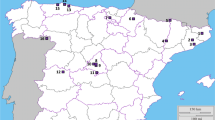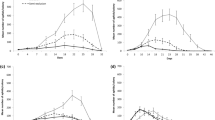Summary
The two aphid species feeding on goldenrod (Solidago altissima) in northern Florida (U.S.A.) exhibited behavioral differences that resulted in characteristic spatial patterns. Uroleucon nigrotuberculatum alates (winged forms) aggregated when colonizing stems and subsequent non-winged generations were relatively sedentary, resulting in a clumped spatial pattern. U. tissoti colonized stems singly and was more mobile; these behaviors resulted in its more random spatial pattern within fields of goldenrod.
Manipulations of aphid density in the field revealed that although patches with high densities of aphids accumulated more predators than patches with few aphids, predation pressure (measured as number of predators per aphid) was lower in dense patches. As a result, aphids in dense patches had a higher per capita change in density than aphids in sparse patches. However, when the fungal pathogen, Neozygites fresenii, became the dominant mortality agent, the influence of aphid density on mortality was reversed; aphids in dense patches were then more vulnerable than aphids in sparse patches. Thus the spatial patterns exhibited by the U. nigrotuberculatum and U. tissoti resulted in differences in their relative vulnerability to different natural enemies.
Similar content being viewed by others
References
Cappuccino N (1987) Comparative population dynamics of two goldenrod aphids: spatial patterns and temporal constancy. Ecology 68:1634–1646
Chesson PL, Murdoch WW (1986) Aggregation of the risk: relationships among host-parasitoid models. Am Nat 127:696–715
Dixon AFG (1958) The escape response shown by certain aphids to the presence of the coccinellid Adalia decempunctata (L.). Trans R Entomol Soc London 110:318–334
Edson JL (1982) Predation and the coexistence of similar species of aphids. Dissertation. University of North Carolina, Chapel Hill, North Carolina, USA
Edson JL (1985) The influences of predation and resource subdivision on the coexistence of goldenrod aphids. Ecology 66:1736–1743
Green RH (1966) Measurement of non-randomness in spatial distributions. Res Pop Ecol 8:1–7
Hassell MP (1985) Parasitism in patchy environments: inverse density-dependence can be stabilizing. Institute of Mathematics and its Applications Journal of Mathematics. Appl Biol Med 1:123–133
Hassell MP, May RM (1974) Aggregation in predators and insect parasites and its effect on stability. J Anim Ecol 43:567–594
Hayamizu E (1984) Comparative studies on aggregations among aphids in relation to population dynamics II. Effects on the growth and fecundity of Brevicoryne brassicae and Myzus persicae (Sulzer) (Homoptera: Aphididae). Appl Entomol Zool 19:468–475
Kareiva P (1984) Predator-prey dynamics in spatially-structured populations: manipulating dispersal in a coccinellid-aphid interaction. Lect Notes Biomath 54:368–389
Moran N (1986) Benefits of host plant specificity in Uroleucon (Homoptera: Aphididae). Ecology 67:108–115
Murdoch WW, Oaten A (1975) Predation and population stability. Adv Ecol Res 9:1–131
Murdoch WW, Reeve JD (1987) Aggregation of parasitoids and the detection of density dependence of field populations. Oikos 50:137–140
Root RB (1973) Organization of a plant-arthropod association in simple and diverse habitats: the fauna of Collards (Brassica oleracea). Ecol Monogr
Stamp N (1980) Egg deposition patterns in butterflies: why do some species cluster their eggs rather than deposit them singly? Am Nat 115:367–380
Taylor LR, Woiwod IP, Perry JN (1978) The density-dependence of spatial behaviour and the rarity of randomness. J Anim Ecol 47:383–406
Author information
Authors and Affiliations
Rights and permissions
About this article
Cite this article
Cappuccino, N. Spatial patterns of goldenrod aphids and the response of enemies to patch density. Oecologia 76, 607–610 (1988). https://doi.org/10.1007/BF00397877
Received:
Issue Date:
DOI: https://doi.org/10.1007/BF00397877




